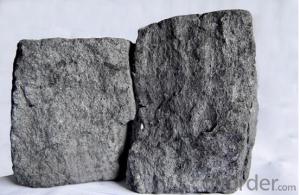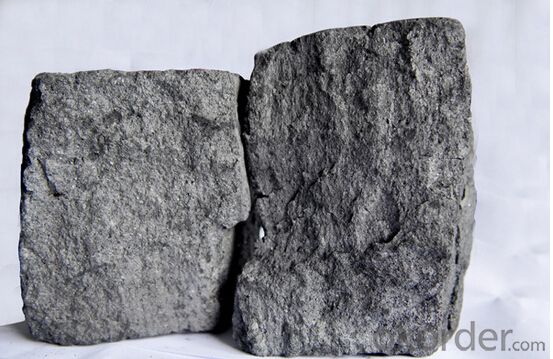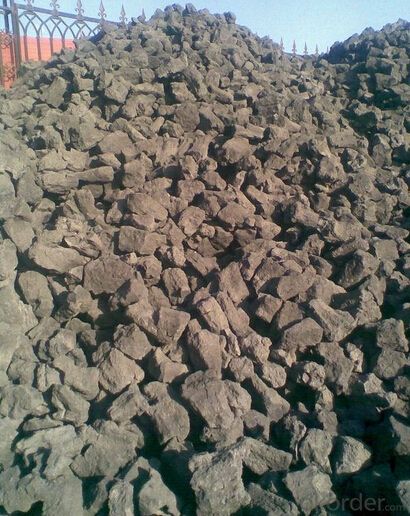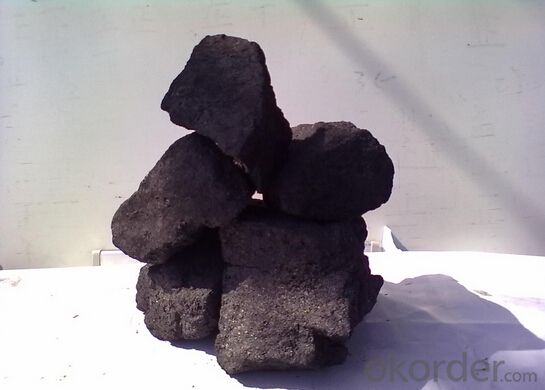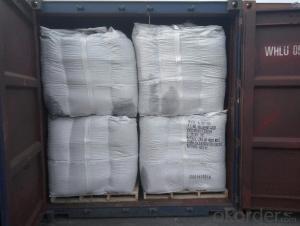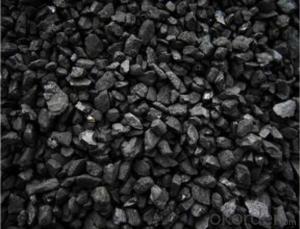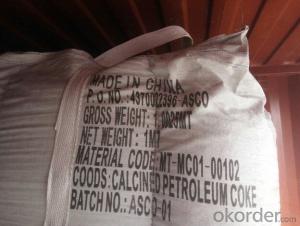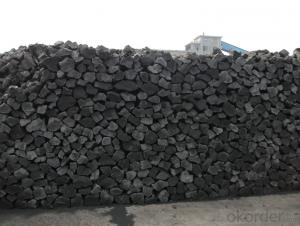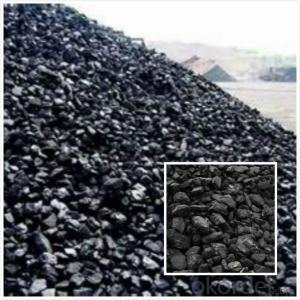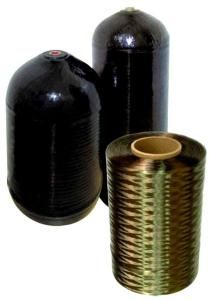Foundry coke (SIZE80--120MM) with Chinese best price
- Loading Port:
- Dalian
- Payment Terms:
- TT OR LC
- Min Order Qty:
- 10 m.t
- Supply Capability:
- 500000 m.t/month
OKorder Service Pledge
Quality Product, Order Online Tracking, Timely Delivery
OKorder Financial Service
Credit Rating, Credit Services, Credit Purchasing
You Might Also Like
Specifications of foundry coke:
High quality products of Foundry coke
- Quick delivery with strong package
- Competitive price
- High quality
Packaging & Delivery:
Packaging Detail: | 25Kg pp or tone bag |
Delivery Detail: | 10 DAYS SINCE TODAY |
Foundry coke data sheet:
F.C | 86%MIN |
ASH | 12%MAX |
VM | 1.5%MAX |
S | 0.6%MAX |
SIZE | 80--120mm |
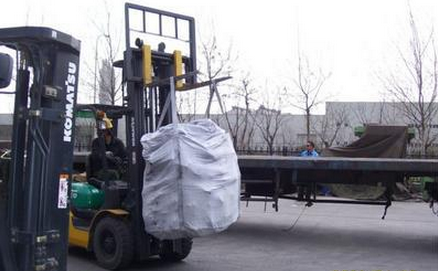
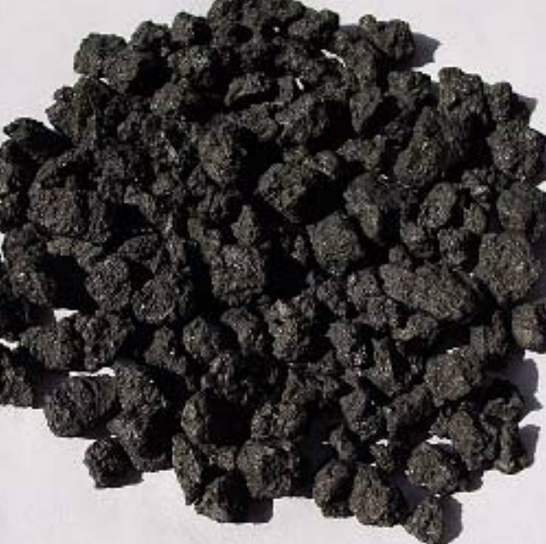
- Q: What do you stand for?Tar, smoke, nicotine, and carbon monoxide. What do you mean? What's the size of the smoke, or the size of the smoke? What's the connection? Smoking is harmful, so how do you choose to smoke smaller cigarettes?
- Compared with the 1mg now, but the taste of light to you simply don't get things, unable to meet the physiological needs, will be more big. So the deep harm than simple 5mg smoke into the lungs and then exhale.Just feel well enough on the line. This was something very mysterious, you can go to a professional ask smoking community. Um. Provide a product Baidu search on it. Is a product tasting tea smoke forum.
- Q: What are the impacts of carbon emissions on urban environments?
- Carbon emissions have significant impacts on urban environments. One of the most notable effects is air pollution. The release of carbon dioxide and other greenhouse gases from vehicles, factories, and power plants contributes to the formation of smog and harmful particulate matter in cities. This pollution poses serious health risks to residents, particularly those with respiratory conditions, and can lead to increased hospital admissions and premature deaths. Furthermore, carbon emissions contribute to climate change, which has wide-ranging consequences for urban areas. Rising temperatures and changing weather patterns can intensify heatwaves, leading to heat-related illnesses and deaths. Increased frequency and severity of extreme weather events, such as hurricanes and floods, can cause significant infrastructure damage and disrupt essential services like water supply and transportation. Urban areas also face the threat of rising sea levels due to carbon emissions. Coastal cities are particularly vulnerable to flooding and erosion as the melting of polar ice caps and thermal expansion of seawater continue. This can result in the loss of valuable land, displacement of populations, and damage to critical infrastructure, including buildings, roads, and sewage systems. Carbon emissions also contribute to the urban heat island effect, wherein cities experience higher temperatures compared to surrounding rural areas. This is due to the absorption and retention of heat by concrete, asphalt, and other urban materials. The urban heat island effect can exacerbate the health risks associated with heatwaves and increase energy demands for cooling, further contributing to carbon emissions. Finally, carbon emissions have economic impacts on urban environments. The costs of mitigating and adapting to the effects of climate change, such as implementing climate-resilient infrastructure and disaster response measures, can be significant. Additionally, the health consequences of air pollution and extreme weather events can lead to increased healthcare costs and productivity losses. To mitigate these impacts, efforts should be made to reduce carbon emissions through transitioning to cleaner energy sources, promoting sustainable transportation options, and implementing energy-efficient practices in buildings. Urban planning and design should also prioritize green spaces, tree planting, and the use of reflective and permeable materials to combat the urban heat island effect. By addressing carbon emissions in urban environments, we can create healthier, more resilient cities for both current and future generations.
- Q: How does carbon impact the prevalence of tsunamis?
- The prevalence of tsunamis is not directly impacted by carbon dioxide. Tsunamis primarily occur due to undersea earthquakes, volcanic eruptions, or underwater landslides. These events release massive amounts of energy into the water, creating powerful waves that can travel across the ocean and cause devastating destruction upon reaching the coast. Although tsunamis are not directly caused by carbon dioxide emissions, there is a connection to climate change, which can indirectly influence the frequency and impact of these natural disasters. The increased levels of carbon dioxide and other greenhouse gases in the atmosphere contribute to global warming, resulting in the rise of sea levels. As the sea levels rise, coastal areas become more susceptible to the destructive force of tsunamis, as the waves can penetrate further inland. Additionally, climate change can also have an impact on the frequency and intensity of extreme weather events like hurricanes and tropical storms. These weather patterns can trigger underwater landslides or increase the likelihood of volcanic eruptions, both of which can lead to the occurrence of tsunamis. In conclusion, while carbon dioxide emissions do not directly cause tsunamis, they do play a role within the broader context of climate change. This indirect impact can result in rising sea levels and the potential for more frequent extreme weather events, ultimately affecting the prevalence and impact of tsunamis.
- Q: What is the difference in carbon content of low carbon steel, medium carbon steel and high carbon steel?
- The carbon content of medium carbon steel (AISI1029 to 1053) is 0.25% to 0.55%, manganese content is 0.30% to 1%, phosphorus content is not more than 0.04%, sulfur content is not more than 0.05%.
- Q: How does carbon affect food production?
- Carbon affects food production in several ways. First, carbon dioxide (CO2) is a critical component for photosynthesis, the process by which plants convert sunlight into energy and produce oxygen. Without sufficient carbon dioxide levels, plants cannot grow and produce food. However, excessive carbon emissions from human activities, such as burning fossil fuels, have led to increased concentrations of CO2 in the atmosphere. This can enhance plant growth initially, but if not balanced with other essential nutrients, it can lead to nutrient imbalances and reduced crop quality. Secondly, carbon is also a key element in the soil organic matter, which is crucial for soil fertility and health. Soil organic matter helps retain moisture, improves soil structure, and provides a habitat for beneficial microorganisms. High levels of carbon in the soil promote healthier plant growth, increase nutrient availability, and enhance water-holding capacity. However, unsustainable agricultural practices, such as excessive tilling and deforestation, can deplete soil carbon, leading to decreased fertility, erosion, and reduced food production. Furthermore, the increase in carbon emissions has contributed to global climate change, resulting in extreme weather events such as droughts, floods, and heatwaves. These events can have devastating consequences on food production. Droughts reduce water availability, making it challenging for crops to grow, while floods can wash away entire harvests. Heatwaves can damage crops, reduce yields, and increase the prevalence of pests and diseases. Climate change also alters the timing and distribution of rainfall, affecting planting and harvesting schedules and disrupting agricultural systems. Moreover, carbon emissions contribute to the acidification of oceans. Increased CO2 in the atmosphere leads to higher levels of dissolved carbon dioxide in seawater, forming carbonic acid. This acidification affects marine ecosystems, disrupting the food chain and impacting fish populations that serve as a vital protein source for many people. To mitigate the negative effects of carbon on food production, it is crucial to reduce carbon emissions and transition to more sustainable agricultural practices. This includes adopting climate-smart farming techniques such as agroforestry, conservation agriculture, and organic farming. These practices promote carbon sequestration in soils, reduce greenhouse gas emissions, enhance biodiversity, and improve soil health. Additionally, investing in research and development of climate-resilient crop varieties and improved irrigation systems can help minimize the impacts of climate change on food production.
- Q: How does carbon impact the ozone layer?
- Carbon does not directly impact the ozone layer. However, certain carbon compounds, such as chlorofluorocarbons (CFCs), can contribute to ozone depletion when released into the atmosphere.
- Q: How does carbon affect the formation of haze?
- Haze formation is significantly influenced by carbon, as it has the ability to interact with other pollutants and atmospheric conditions. When carbon-containing compounds, such as emissions from fossil fuels or organic matter from wildfires, are released into the atmosphere, they undergo chemical reactions with gases like nitrogen oxides and volatile organic compounds. These reactions lead to the creation of tiny particles called secondary organic aerosols (SOAs), which are suspended in the air. The presence of these SOAs can contribute to the formation of haze by scattering and absorbing sunlight, resulting in reduced visibility and a hazy appearance. Additionally, the carbon particles act as nuclei for condensation, attracting other pollutants and water vapor, ultimately leading to the formation of larger particles and, consequently, haze. Moreover, the interaction between carbon and atmospheric moisture can result in the formation of secondary organic aerosol particles, further contributing to haze formation. Furthermore, carbon particles also play a role in the formation of photochemical smog, a specific type of haze characterized by high levels of ozone. Carbon-containing pollutants can react with sunlight and other pollutants, leading to the production of ozone. The presence of ozone, combined with other pollutants, contributes to the formation of haze and decreases air quality. To summarize, the impact of carbon on haze formation is significant, as it contributes to the creation of secondary organic aerosols, acts as condensation nuclei, and promotes the production of ozone. Understanding the role of carbon in haze formation is crucial for implementing effective measures to control air pollution and mitigate the adverse effects of haze on human health and the environment.
- Q: The difference between graphite and carbon
- There are three kinds of carbon allotropes, namely diamond, graphite and amorphous carbon.Graphite is a crystalline mineral of carbonaceous elements, and its crystalline framework is hexagonal layered structure
- Q: How is carbon formed in stars?
- Nuclear fusion is the process by which carbon is produced in stars. Hydrogen atoms in the star's core go through a series of fusion reactions, eventually combining to form helium. This fusion process emits a massive amount of energy and is responsible for the heat and light emitted by stars. As the star's core grows hotter and the pressure increases, helium atoms begin to fuse, creating heavier elements. At a certain point, three helium nuclei can come together to form a carbon nucleus. This process, called the triple alpha process, requires specific conditions, including high temperature and pressure, for it to occur. The triple alpha process relies on the fact that carbon-12 possesses a distinct energy level that allows three helium nuclei to unite and create a stable carbon nucleus. This is due to the perfect alignment of carbon-12's energy level with those of helium nuclei, enabling them to overcome electrostatic repulsion and fuse together. Once carbon is generated in the star's core, it can undergo further fusion reactions, resulting in the creation of even heavier elements like oxygen and nitrogen. These elements are vital building blocks for the formation of planets, including our own Earth, as they eventually get expelled into space during the later stages of a star's evolution.
- Q: What are the effects of carbon emissions on the stability of river systems?
- Carbon emissions have significant effects on the stability of river systems. Increased carbon emissions contribute to global warming, leading to rising temperatures and altered precipitation patterns. These changes can result in more frequent and intense extreme weather events, including floods and droughts, which disrupt the natural flow of rivers. Carbon emissions also contribute to ocean acidification, which affects freshwater sources through underground aquifers and alters the pH levels of rivers, impacting the stability of ecosystems. Additionally, carbon emissions can lead to the formation of harmful algal blooms, depleting oxygen levels in rivers and harming aquatic life. Overall, carbon emissions have profound implications for the stability and functioning of river systems.
Send your message to us
Foundry coke (SIZE80--120MM) with Chinese best price
- Loading Port:
- Dalian
- Payment Terms:
- TT OR LC
- Min Order Qty:
- 10 m.t
- Supply Capability:
- 500000 m.t/month
OKorder Service Pledge
Quality Product, Order Online Tracking, Timely Delivery
OKorder Financial Service
Credit Rating, Credit Services, Credit Purchasing
Similar products
Hot products
Hot Searches
Related keywords
